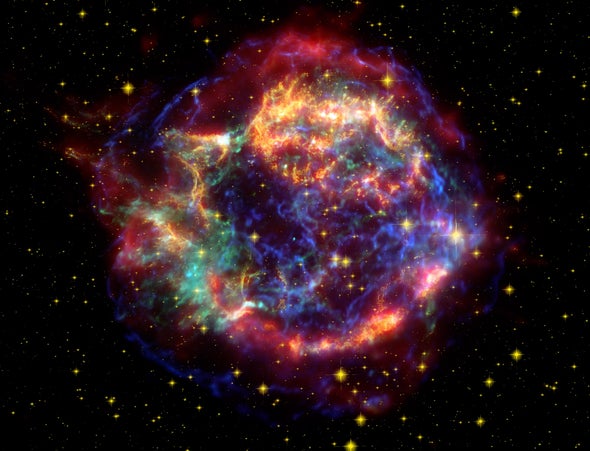 Initially before making this passion blog, I wanted to write about wormholes and wether or not time travel could be possible using these theoretical bodies, but that was simply too much math and science for me to comprehend so instead I am writing about supernovas because explosions are much easier to understand. A supernova is essentially when a star explodes. These explosions are the brightest and most powerful in the universe. For scale, the strongest supernova ever recorded was 600 billion times brighter than our sun, and produced more 10^44 joules, or more energy than our sun would over 10 billion years. There are two ways supernovas can take place. A star can turn into a supernova in two ways. The first way a supernova can take place is when a star accumulates matter from a nearby white dwarf until a runaway nuclear reaction ignites. While one star must be a white dwarf, the other star can be any type. Once the white dwarf has stolen enough mass to use as fuel from the other star, 1.4 the mass of the sun to be precise, the white dwarf will explode. These explosions are more rare and much tamer compared to the second type, called core-collapse supernovas. These supernovas occur when a star 8 to 15 times larger than our sun runs out of hydrogen and helium at its core. Once this happens, the heavier elements begin to sink towards the star’s core, while the lighter ones rise to the surface. Eventually, these heavier add to to the core’s mass until the star reaches the Chandrasekhar limit, which is when the core heats up and eventually implodes from the added mass, creating the supernova. While supernovas are the most violent and powerful explosions in the universe, there is a part of the former star left behind called a neutron star. Neutron stars are typically very small as far as celestial objects go, and are formed by gravity pulling the remaining parts of the star’s core together to create a new object all together. The first supernova to ever be observed was seen by astronomer Alicia Soderberg in 2008. She was monitoring a star when suddenly, her computer registered extreme brightness and a release of X-rays. This went on for about 5 minutes and was considered to be an astronomical find (pun intended) in the field of astronomy. So important in fact, that it was regarded the most fascinating observation of a celestial process up until scientists photographed a black hole this year. With more advanced technology and satellites and probes traveling farther and farther into space each year, perhaps one day, we will successfully be able to record a supernova without the device being destroyed. The chances of a manmade craft being in the right place at the right time at the right distance is slim, but I think I speak for all humanity when I say that we would all like to see a star go boom.
Initially before making this passion blog, I wanted to write about wormholes and wether or not time travel could be possible using these theoretical bodies, but that was simply too much math and science for me to comprehend so instead I am writing about supernovas because explosions are much easier to understand. A supernova is essentially when a star explodes. These explosions are the brightest and most powerful in the universe. For scale, the strongest supernova ever recorded was 600 billion times brighter than our sun, and produced more 10^44 joules, or more energy than our sun would over 10 billion years. There are two ways supernovas can take place. A star can turn into a supernova in two ways. The first way a supernova can take place is when a star accumulates matter from a nearby white dwarf until a runaway nuclear reaction ignites. While one star must be a white dwarf, the other star can be any type. Once the white dwarf has stolen enough mass to use as fuel from the other star, 1.4 the mass of the sun to be precise, the white dwarf will explode. These explosions are more rare and much tamer compared to the second type, called core-collapse supernovas. These supernovas occur when a star 8 to 15 times larger than our sun runs out of hydrogen and helium at its core. Once this happens, the heavier elements begin to sink towards the star’s core, while the lighter ones rise to the surface. Eventually, these heavier add to to the core’s mass until the star reaches the Chandrasekhar limit, which is when the core heats up and eventually implodes from the added mass, creating the supernova. While supernovas are the most violent and powerful explosions in the universe, there is a part of the former star left behind called a neutron star. Neutron stars are typically very small as far as celestial objects go, and are formed by gravity pulling the remaining parts of the star’s core together to create a new object all together. The first supernova to ever be observed was seen by astronomer Alicia Soderberg in 2008. She was monitoring a star when suddenly, her computer registered extreme brightness and a release of X-rays. This went on for about 5 minutes and was considered to be an astronomical find (pun intended) in the field of astronomy. So important in fact, that it was regarded the most fascinating observation of a celestial process up until scientists photographed a black hole this year. With more advanced technology and satellites and probes traveling farther and farther into space each year, perhaps one day, we will successfully be able to record a supernova without the device being destroyed. The chances of a manmade craft being in the right place at the right time at the right distance is slim, but I think I speak for all humanity when I say that we would all like to see a star go boom.